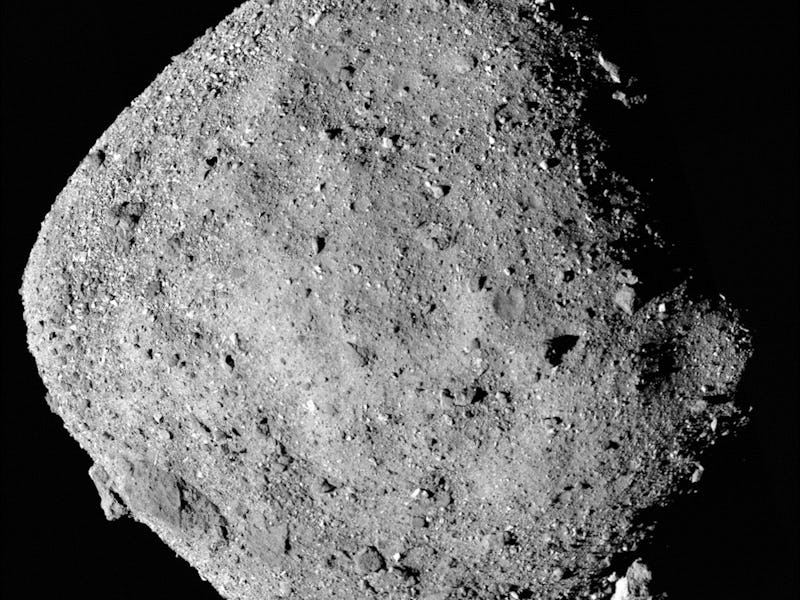Why the asteroid Bennu has a minuscule chance of hitting Earth
Overall odds that the asteroid will hit the Earth through the year 2300 are around one in 1,750 or a mere 0.057 percent.

The people of the 22nd and 23rd centuries have a little less to worry about as of Wednesday, as NASA scientists have confirmed there is little likelihood that the half-kilometer-wide near-Earth asteroid Bennu will strike Earth when it passes nearby in 2135.
More importantly, they’ve also eliminated two dozen potential scenarios following that close encounter, some of which could have put Bennu on a collision course with Earth in the years that follow. Overall odds that the asteroid will hit the Earth through the year 2300 are around one in 1,750 or a mere 0.057 percent.
The findings were published Wednesday in the journal Icarus and are among the first major results from NASA’s OSIRIS-REx mission, which took three years orbiting Bennu in 2018 before taking a sample of the asteroid on October 20, 2020.
Findings derived from studying the OSIRIS-REx returned samples combined with the current study will advance planetary science and scientists' understanding of Bennu and inform models that can be used to predict better the orbits of all potentially hazardous asteroids in the Solar System.
“Planetary defense, as I like to say, is applied planetary science,” NASA’s Planetary Defense Officer Lindley Johnson told reporters on Wednesday. “Closer study of asteroids tells us what we need to know about them to discover better, characterize and mitigate any potential impact hazards to Earth.”
What the scientists discovered— Bennu was first discovered in 1999 and has been studied extensively so that its orbit was already one of the most well understood of all potentially hazardous asteroids, says Davide Farnocchi, the lead author on the study in Icarus.
So scientists already knew that Bennu was going to pass relatively close — within the moon's orbit — to Earth in 2132. Still, it was not clear if that flyby, in connection with other factors, would set the asteroid on a collision course with Earth later in the century.
They had calculated 26 “gravitational keyholes,” Farnocchi said in the media briefing. Those keyholes are windows in space that would set Bennu on a course to later smash into Earth if passed through.
But to understand the likelihood that Bennu will pass through one of the keyholes in 2135, scientists needed to know its precise position just before the asteroid’s future encounter with Earth, and that necessitated measurements of Bennu that could not be made from the ground: precise measurements of its mass, shape, rotation and thermal properties that could affect the asteroid’s orbit over time.
With those measurements made possible by data collected during the OSIRIS-REx mission, Farnocchi said his team improved their predictions of Bennu’s future trajectory by a factor of 20 and eliminated all but two of the possible keyholes from Bennu’s future path.
The most significant chance for an impact would be in 2182, but “we should keep in mind that the impact probability overall is really small,” Farnocchi said. “There is a 99.94 percent probability that Bennu is not on an impact trajectory, so there's no particular reason for concern.”
The near Earth asteroid Bennu.
The final word — Whether Bennu poses a threat to Earth in 2182 won’t come until 2135 when the asteroid’s first close pass actually happens and can be observed. But that would still give the scientists and engineers of the day plenty of time to react should Bennu take an unfortunate turn.
“The biggest factor in being able to select an object is how far in advance we can find them before a potential impact,” Johnson said. “With Bennu, we know about it almost two centuries before it could pose a threat.”
Hopefully, he added, the technology of 100 years in the future will be up to the challenge of mitigating a Bennu impact. After all, Johnson and scientists of today are working on just such technologies now, including The Double Asteroid Redirection Test, or DART, which will attempt to use a kinetic impact vehicle to change the orbit of a small moonlet around the larger asteroid Didymos. DART is currently scheduled to launch in November.
Johnson also mentioned the Near Earth Object Surveyor mission, planned for 2026, which will help NASA map objects of Bennu’s size in the Solar System. He noted during the media briefing that NASA estimates it has discovered about 79 percent of such objects, but that “there is a way to go.”
What’s next for OSIRIS Rex and the mission?—The OSIRIS-REx spacecraft is currently headed back to Earth to return its Bennu sample and should arrive on September 24, 2023. After that, it’s up to NASA as to whether or not it wants to extend the spacecraft's mission and fly elsewhere, according to OSIRIS-REx Principal Investigator Dante Lauretta. “We have this fantastic spacecraft with a lot of instruments that are still capable on it and we have looked at where else the spacecraft could go,” he said at the media briefing. “We will submit our concept to the agency in early 2022.”
This article was originally published on